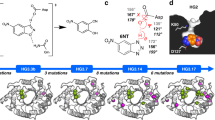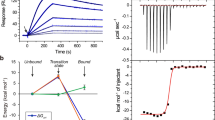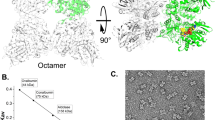Abstract
Here we show that the substitution Thr 26→His in the active site of T4 lysozyme causes the product to change from the α- to the β-anomer. This implies an alteration in the catalytic mechanism of the enzyme. From the change in product, together with inspection of relevant crystal structures, it is inferred that wild-type T4 lysozyme is an anomer-inverting enzyme with a single displacement mechanism in which water attacks from the α-side of the substrate. In contrast, the mutant T26H is an anomer-retaining enzyme with an apparently double displacement mechanism in which a water molecule attacks from the opposite side of the substrate. The results also show that the mechanism of wild-type T4 lysozyme differs from that of hen egg-white lysozyme even though both enzymes are presumed to have evolved from a common precursor.
This is a preview of subscription content, access via your institution
Access options
Subscribe to this journal
Receive 12 print issues and online access
$189.00 per year
only $15.75 per issue
Buy this article
- Purchase on Springer Link
- Instant access to full article PDF
Prices may be subject to local taxes which are calculated during checkout
Similar content being viewed by others

References
Bowie, J.U., Reidhaar-Olson, J.F., Lim, W.A. & Sauer, R.T. Deciphering the message in protein sequences: Tolerance to amino acid substitutions. Science 247, 1306–1310 (1990).
Matthews, B.W. Structural and genetic analysis of protein stability. A. Rev. Biochem. 62, 139–160 (1993).
Grütter, M.G., Weaver, L.H. & Matthews, B.W. Goose lysozyme structure: an evolutionary link between hen and bacteriophage lysozymes? Nature 303, 828–831 (1983).
Blake, C.C.F. et al. Structure of hen egg-white lysozyme. A three-dimensional Fourier synthesis at 2 Å resolution. Nature 206, 757–761 (1965).
Matthews, B.W. & Remington, S.J. The three-dimensional structure of the lysozyme from bacteriophage T4. Proc. natn. Acad. Sci. U.S.A. 71, 4178–4182 (1974).
Svensson, B. & Søgaard, M. Mutational analysis of glycosylase function. J. Biotechnology 29, 1–37 (1993).
Jacobson, R.H., Zhang, X.-J., DuBose, R.F. & Matthews, B.W. Three-dimensional structure of β-galactosidase from E. coli. Nature 369, 761–766 (1994).
Jenkins, J., Leggio, L.L., Harris, G. & Pickersgill, R. & Pickersgill, R β-Glucosidase, β-galactosidase, family A cellulases, family F xylanases and two barley glycanases form a superfamily of enzymes with 8-fold β/α architecture and with two conserved glutamates near the carboxy-terminal ends of β-strands four and seven. FEBS Lett. 362, 281–285 (1995).
Weaver, L.H., Grütter, M.G. & Matthews, B.W. The refined structures of goose lysozyme and its complex with a bound trisaccharide show that the “goose-type” lysozymes lack a catalytic aspartase residue. J. molec. Biol. 245, 54–68 (1995).
Koshland, D.E. Stereochemistry and the mechanism of enzymatic reactions. Biol. Rev. 28, 416–436 (1953).
Phillips, D.C. The hen egg-white lysozyme molecule. Proc. natn. Acad. Sci.U.S.A. 57, 484–495 (1967).
Sinnott, M.L. Catalytic mechanisms of enzymic glycosyl transfer. Chem. Rev. 90, 1171–1202 (1990).
Strynadka, N.C.J. & James, M.N.G. Lysozyme revisited: crystallographic evidence for distortion of an N-acetylmuramic acid residue bound in site D. J. molec. Biol. 220, 401–424 (1991).
Anand, N.N., Stephen, E.R. & Narang, S.A. Mutation of active site residues in synthetic T4-lysozyme gene and their effect on lytic activity. Biochem. biophys. Res. Commun. 153, 862–868 (1988).
Malcolm, B.A. et al. Site-directed mutagenesis of the catalytic residues Asp-52 and Glu-35 of chicken egg white lysozyme. Proc. natn. Acad. Sci. U.S.A. 86, 133–137 (1989).
Hardy, L.W. & Poteete, A.R. Reexamination of the role of Asp20 in catalysis by bacteriophage T4 lysozyme. Biochemistry 30, 9457–9463 (1991).
Rennell, D., Bouvier, S.E., Hardy, L.W. & Poteete, A.R. Systematic mutation of bacteriophage T4 lysozyme. J. molec. Biol. 222, 67–87 (1991).
Shoichet, B.K., Baase, W.A., Kuroki, R. & Matthews, B.W. A relationship between protein stability and protein function. Proc. natn. Acad. Sci. U.S.A. 92, 452–456 (1995).
Kuroki, R., Weaver, L.H. & Matthews, B.W. A covalent enzyme-substrate intermediate with saccharide distortion in a mutant T4 lysozyme. Science 262, 2030–2033 (1993).
Bienkowska, K. & Taylor, A. Low-molecular-weight substrate for the lysozyme of T4 bacteriophage. Eur. J. Biochem. 96, 581–584 (1979).
Glauner, B. Separation and quantification of muropeptides with high-performance liquid chromatography. Anal. Biochem. 172, 451–464 (1988).
Dahlquist, F.W., Borders, C.L., Jacobson, G. & Raftery, M.A. The stereospecificity of human, hen, and papaya lysozymes. Biochemistry 8, 694–700 (1969).
Weaver, L.H. & Matthews, B.W. Structure of bacteriophage T4 lysozyme refined at 1.7 Å resolution. J. molec. Biol. 193, 189–199 (1987).
Tomme, P. et al. Identification of a histidyl residue in the active center of endoglucanase D from Clostridium thermocellum. J. biol. Chem. 266, 10313–10318 (1991).
Py, B., Bortoli-German, I., Haiech, J., Chippaux, M. & Barras, F. Cellulase EGZ of Erwinia chrysanthemi: Structural organization and importance of His 98 and Glu 133 residues for catalysis. Protein Engng. 4, 325–333 (1991).
Nickbarg, E.B., Davenport, R.C., Petsko, G.A. & Knowles, J.R. Triosephosphate isomerase: Removal of a putatively electrophilic histidine residue results in a subtle change in catalytic mechanism. Biochemistry 27, 5948–5960 (1988).
Wang, Q., Graham, R.W., Trimbur, D., Warren, R.A.J. & Withers, S.G. Changing enzymatic reaction mechanisms by mutagenesis: Conversion of a retaining glucosidase to an inverting enzyme. J. Am. chem. Soc. 116, 11594–11595 (1994).
Muchmore, D.C., Mclntosh, L.P., Russell, C.B., Anderson, D.E. & Dahlquist, F.W. Expression and 15N labelling of proteins for proton and nitrogen-15 NMR. Meths Enzymol. 177, 44–73 (1989).
Poteete, A.R., Dao-pin, S., Nicholson, H. & Matthews, B.W. Second-site revertants of an inactive T4 lysozyme mutant restore activity structuring the active site cleft. Biochemistry 30, 1425–1432 (1991).
Streisinger, G., Mukai, F., Dreyer, W.J., Miller, B. & Horiuchi, S. Mutations affecting the lysozyme of phage T4. Cold Spring Harb. Symp. quant. Biol. 26, 25–30 (1961).
Tronrud, D.E., Ten Eyck, L.F. & Matthews, B.W. An efficient general-purpose least-squares refinement program for macromolecular structures. Acta Crystallogr. A43, 489–503 (1987).
Author information
Authors and Affiliations
Rights and permissions
About this article
Cite this article
Kuroki, R., Weaver, L. & Matthews, B. Structure-based design of a lysozyme with altered catalytic activity. Nat Struct Mol Biol 2, 1007–1011 (1995). https://doi.org/10.1038/nsb1195-1007
Received:
Accepted:
Issue Date:
DOI: https://doi.org/10.1038/nsb1195-1007
This article is cited by
-
Backbone 1H, 13C, and 15N resonance assignments for lysozyme from bacteriophage lambda
Biomolecular NMR Assignments (2010)
-
Chitinases, chitosanases, and lysozymes can be divided into procaryotic and eucaryotic families sharing a conserved core
Nature Structural Biology (1996)
-
Turning lysozyme upside down
Nature Structural & Molecular Biology (1995)


